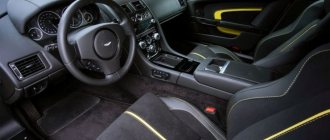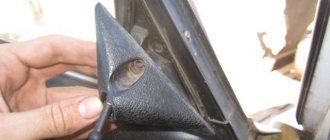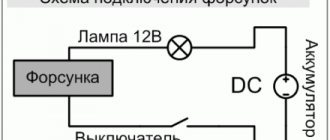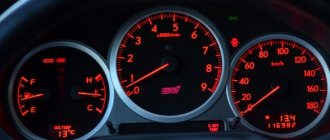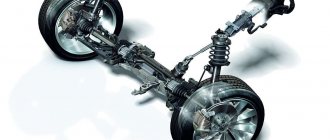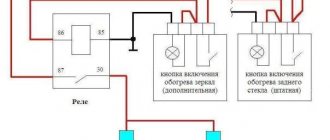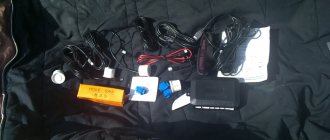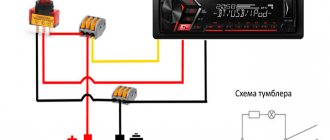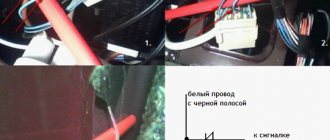What you need
To make a heater you only need:
- Nichrome wire;
- Double-sided and regular tape;
- Wires;
- Sealant;
- Soldering iron;
- Multimeter;
Having all this, you can start equipping the mirrors with heating. But first, let's deal with nichrome wire.
A wire with a cross section of 0.4-05 mm and a length of 1-1.3 m is suitable for the heater. For normal functioning of the heating system, the resistance of the piece of wire must be 12 Ohms. This is exactly what a multimeter is for. That is, we took a section of 1.5 meters and measured the resistance. If it exceeds the specified value, cut off 10 cm and measure again. Thus, we select the desired segment.
Procedure
Now you can begin installing the heater. First, remove the holder with the mirror from the case. On most cars, it is enough to pry it with a screwdriver or something flat from below and pull it towards you.
Based on the characteristics of the holder, we choose the method of fastening the wire. If the inner surface of the holder is smooth (as in the photo), then stick double-sided tape on it.
Then we lay a piece of wire on this surface. This can be done arbitrarily, for example, in a zigzag or something else. The main thing is to place it so that the thread covers as much of the surface of the holder as possible. In this case, the wire should not intersect anywhere. Scotch tape will hold the nichrome thread well.
If the inner surface of the holder has any protrusions or fastening elements, then it will not be possible to stick the tape. In this case, a soldering iron will help to secure the wire. Everything is simple here - we apply a nichrome thread to the surface and press it with a heated soldering iron. The plastic will begin to melt and the wire will sink into it. Once cooled, the plastic will become hard and will hold the thread. But here it is important not to overdo it with heating the plastic, so as not to “push” it to the mirror. It is enough just to “drown” the wire in it a little and that’s it.
In this way, we fasten the wire along the accessible surface of the holder without touching the fasteners.
When laying the wire, its ends should be placed towards the side of the holder that is closer to the door, and so that they do not touch each other. To these ends we solder terminals for connecting to the wiring or simply the ends of prepared wires. Then the resulting connections need to be insulated.
Connection
All that remains is to connect the manufactured device. The best option for this is to insert it into the rear window heating wiring or connect it to the heating switch. It is important to take into account that the load on this section of the wiring will increase after the heaters are turned on, so the fuse responsible for powering the heated rear window should be replaced.
But you can simply make a separate power key and place it in a convenient place. But with such a connection, there is one drawback - you can forget to turn off the heated mirrors after parking the car.
Do-it-yourself installation of heated mirrors on a Lada Granta - step-by-step instructions
1. First of all, you need to remove the rear view mirror. To do this, bend the mirror and unscrew the latches located in a circle.
2. Next we dismantle the mirror covers. The latches are clearly visible from the side of the removed mirror.
3. After this, we proceed to removing the door card. Everything is simple here, I think you’ll figure it out. For those who still need instructions, read this article, which describes everything in detail.
4. We insert the power wires of the heating element into the hole in which the wiring is laid.
5. Next, you need to disassemble the connecting block; I’ll tell you right away - it’s not an easy task. Pushing the wiring through the block, as well as the rubber corrugation into the interior, is quite difficult. True, if you know certain secrets, you can make your life much easier. To do this, you will need a thin round file, which is very convenient for drilling a hole in the block, into which the “-” power wire for the heated mirrors will then fit perfectly. We do the same with the “+” wire.
6. Next, we pull the wire through the rubber corrugation.
7. We connect the negative wires to the ground screw near the fuse box. I connected the positive wires to the fuse holder and heat-shrink everything.
8. In the bundle of wires we find two gray wires (the first goes to the fuel pump, the second powers the heated rear window , which is what we need).
Video - how to make heated mirrors
Good afternoon Autumn is coming, it rains more and more often... When splashes of water hit the mirrors, visibility deteriorates sharply. I decided to correct this situation by installing heated mirror elements.
Going to the store: so, we will need:
1. Heated mirror elements – 2 pcs. 2. 4-pin relay – 1 pc. 3. Button – 1 pc. 4. Relay connector – 1 pc. 5. Button connector – 1 pc. 6. “Crocodiles” - 6 pcs. 7. Small connectors (like on speakers) – 15 pcs. 8. Power cable – 8 m. 9. Heat-shrinkable tubes – (small set). 10. Electrical tape. 11. Nylon ties – 30 pcs. 12. Pistons (if they break when removing the door cards). - 5 pieces.
Required tool:
1. Phillips screwdriver. 2. Slotted screwdriver – thin, long (for disassembling mirrors). 3. Small pliers (for crimping connectors). 4. Wire cutters. 5. Scissors. 6. Knife. 7. WD-40 lubricant. 8. Rags. 9. A piece of rigid copper wire (to pull the wires through).
Let's start installing heated mirror elements:
1. Remove the mirrors from the doors.
Yes, it's better to take it off. It will turn out more accurately, faster. In one thing, you can restore the flexion function (my mirrors turned sour and did not fold). To remove the mirror, we need to remove the decorative plastic cover from which the lever for controlling the mirror element sticks out (the cover has latches, just pull it towards you). Then remove the retaining ring and unscrew the 3 bolts. Attention! Unscrew the last bolt while holding the mirror with your hand, otherwise bang.
2. To dismantle the old mirror elements, turn the mirror element as much as possible in any direction so that there is a gap where you can insert a screwdriver. Our task is to pry off the latches of the mirror element. We unclip all the latches and separate the old mirror element.
3. Take the cable and divide it in half. We attach connectors to the wires for connection to the new mirror element. Be sure to use heat shrink tubing. 4. We insert the wire into the technological holes of the mirror housing. We apply the mirror element “at home”. Press lightly until you hear a click. We make sure that the element is in place. 5. We do the same procedure with the second mirror. Attention! I strongly recommend that you try to connect all the wires according to the diagram “on your knees”, make sure that you understand the diagram and understand what to connect and where! Let's make sure the mirrors are warm!
Let's move on. 6. We screw the mirrors to the doors in the reverse order of dismantling. We cut one wire and press it with a bolt to the exposed part of the door. This will give us mass.
7. Remove the door cards (trimming). Look for articles on the Internet or in books. There is nothing complicated. 8. We pass the wire through the technological holes in the door. Disconnect the wiring block between the door and the body (turn the ring and pull it towards you). Our task is to insert the wire into the rubber corrugation. If you do it wisely, you need to prepare small connectors, install them in the block, connect the wires, etc., but I was too lazy... I pulled the wire out from the side of the block and stuck it into the corrugation using solid copper wire. It is better to separate the corrugation from the body, it will be more convenient. Yes, we also unscrew one screw in the plastic cover next to the hole in the body (inside the cabin, you’ll understand...). I cut the edge of the corrugation that goes into the interior and pulled it out through the wire cut. It should be immediately noted that we will have 2 wires coming out of the driver’s door, and one from the passenger door. The fact is that I brought the mass to the relay from the door, in theory it can be done from any place, if desired.
Lada Kalina Sedan K-Line › Logbook › Heated mirrors. Part 2. Installation, connection
Heated mirrors.
Installation. Solina kit for Kalina with old type of mirrors. I don’t understand why you put all sorts of stickers and labels on mirrors? I had to use a little solvent to wipe off the remaining glue.
We disassemble the door, the door trim to the side. At the same time I decided to paint the spacers for the front speakers. The paint remained the same color as the car. Well, I was too lazy to unscrew the spacers, we are not looking for easy ways... but it would be worth it.
The wires were already installed in advance, I took care of that. I stretched 4 wires through the door, two were useful, and two more remained as reserve wires; I wrapped them in a ring again.
I removed the mirrors, then the mirror elements themselves. I cleaned it from the inside and lubricated it with silicone.
I ran the heating wiring inside the mirror. I installed everything in place. For ease of installation/disassembly, I soldered the terminals on both sides.
Changes to the fuse box
Initially, the mounting block of the viburnum in the “norm” configuration was like this. True, instead of the power window relay, a jumper has already been installed.
You can see a lot of places for fuses and relays.
A little later, significant changes appeared in the mounting block. 1- dismantled the fog light relay. I wanted to move the K9 to its place, but when I made a smooth ignition of the fog lights, the need for a relay disappeared completely 2- added a couple of fuses for the DRL and recorder, + some other little things 3- reserved a place for the mirror heating relay
But he didn’t stop there. It is known that not all relays and fuses are located in the mounting block. There are 3 installed under the stove, and some have a 4th relay + fuse. (fuel pump relay, main relay, fan relay, + additional fan relay)
The ECU block was moved from under the stove a long time ago so as not to tempt fate: Removing the “brain” or moving the ECU
There are only some relyushki left. Access to them is not convenient, who knows, knows. Somehow my fan did not turn off when the car was turned off for a very, very long time. Cause: relay stuck. To make it easier to control the relays, I decided to move them to the mounting block.
In the photo I highlighted 3 relyushki, which I moved from under the stove. It didn't turn out to be quick, but it was a rest for the brain and a workout for the hands.
I placed the relays on special blocks that are suitable for the VAZ 2110 mounting block, as well as for the old-style mounting block (black mounting block).
A fuse was placed on the right, which was planned to be placed next to the standard 50A fuse at the bottom, but the terminals did not fit. I had to slightly edit the block from the new mounting block (from the gray block). Everything sits as if it were original)))
Types of heating
The need for this function became clear quite a long time ago. Just a few decades ago, some cars were equipped with simple devices designed to defrost viewing structures.
Installation involved installing incandescent lamps inside, which heated the part from the inside and the ice melted. In modern devices, the heating method has changed, but the function remains the same.
The existing types of defrosters should be considered separately:
- Wire - how heated mirrors on a wire base works is explained by its very name. Tungsten filaments are used as a heating element, placed on an insulating and heat-resistant base. When an electric current passes through them, they heat up, which leads to melting of the ice.
- Printed conductors – heated car mirrors using printed conductors are the most modern. You can buy boards at the car market or at a spare parts store. They are not made independently.
- A film heater is a film-based product with heating elements included in it.
- Lamp heater - this type of heating element is a low-power (10 watt) incandescent lamp. This technology is best suited for making heated mirrors with your own hands and is often used by owners of outdated models of domestic cars.
Checking the presence of standard heating
The presence of a heated rear view mirror cannot always be detected at first glance. The fact is that there is often no separate button to turn it on, and many car owners wonder how the heated exterior mirrors are turned on. The function is activated automatically when the rear window heating is turned on. To check if the mirror heater is present:
- Start the engine;
- Turn on the rear window heating;
- Spray the mirrors with water or blow on them;
- Touch it with your hand.
When the heating is running, the water drops dry within 1-2 minutes; when you breathe, the mirror does not fog up, and it is warm to the touch. In the cold season, you can verify the presence of heating by simply observing how long it takes for the mirror to thaw after being parked overnight. If a heating element is located underneath, the defrosting process takes only a few minutes.
Instructions for installing ready-made components
Installing commercial heated mirrors is a relatively simple operation. To carry it out, it is necessary to remove the part from the car and disassemble it. Glued products are heated with a hair dryer or by soaking in boiling water, after which the reflective overlay is easily removed. » alt=»»> Products fastened with bolts are disassembled using the appropriate tool. Do-it-yourself installation of heated rear-view mirrors purchased in a store is permissible only on clean and dry surfaces.
Before starting the procedure, it is necessary to evaluate the dimensions of the heating element and housing. If printed circuit boards are used, it is possible to remove the stiffeners. The film is cut to size while retaining the heating strips.
The boards are glued to the inside of the case with glue, the films are fixed directly to the reverse side. In both cases, wires are soldered to the contacts of the thermoelement, which go to the power source.
Do-it-yourself installation of heated mirrors on a Lada Granta - step-by-step instructions
1. First of all, you need to remove the rear view mirror. To do this, bend the mirror and unscrew the latches located in a circle.
2. Next we dismantle the mirror covers. The latches are clearly visible from the side of the removed mirror.
3. After this, we proceed to removing the door card. Everything is simple here, I think you’ll figure it out. For those who still need instructions, read this article, which describes everything in detail.
4. We insert the power wires of the heating element into the hole in which the wiring is laid.
5. Next, you need to disassemble the connecting block; I’ll tell you right away - it’s not an easy task. Pushing the wiring through the block, as well as the rubber corrugation into the interior, is quite difficult. True, if you know certain secrets, you can make your life much easier. To do this, you will need a thin round file, which is very convenient for drilling a hole in the block, into which the “-” power wire for the heated mirrors will then fit perfectly. We do the same with the “+” wire.
6. Next, we pull the wire through the rubber corrugation.
7. We connect the negative wires to the ground screw near the fuse box. I connected the positive wires to the fuse holder and heat-shrink everything.
8. In the bundle of wires we find two gray wires (the first goes to the fuel pump, the second powers the heated rear window , which is what we need).
9. We connect the fuse holder using a continuous clamp and the wire we need. We install a 15 A fuse in the holder.
10. We connect the elements to the “mothers” on the mirrors, after which we connect the heated mirror elements and install the trim.
11. Assembly is carried out in the reverse order and only after checking the functionality of the heated mirrors .
Flexible heating element for side rear view mirrors for VAZ 1118-1119 (Kalina) and Granta.
- Add to favorites
- Description
- Delivery terms
- Reviews
Attention! The price is for 1 set!
With the arrival of autumn and then winter, more and more motorists are beginning to think about heated rear-view mirrors.
In the rain, it is difficult to make out drops on the mirror what is happening in the next row. In winter, mirrors fog up and become covered in ice.
Unfortunately, car manufacturers will not soon begin to equip every car with such a useful function as heated side mirrors.
But the cleanliness of mirrors directly affects traffic safety.
The offered heaters have several advantages over heating elements from other manufacturers: 1) 6.3 mm male terminals This allows for simplified connection while maintaining build quality. If you need to change the mirror element, the wires are simply disconnected and installed in place, without the need for soldering, twisting or other similar connections. 2) already applied adhesive layer. Special thermal tape has already been applied to the elements at the factory. You don’t need to search and select it in the store, everything is already ready for installation 3) strict quality control control All mirrors undergo mandatory control after manufacturing. This ensures the high quality of the product.
How to make heated mirrors with your own hands
It’s not difficult to make heated mirrors with your own hands. Most often, incandescent lamps or a wire-based heating element system are used for this. The cost of materials is minimal, but the work will take time.
What you will need
To make heated mirrors with your own hands, you will need a set of tools and materials. The list of consumables depends on what type of device the car owner wants to see.
| Lamp | Wire |
| lamp 10 watt | the basis |
| foil | tungsten filaments |
| heat resistant material | Double-sided tape |
| cartridge | wires |
| wires | soldering iron |
| soldering iron | sealant |
| sealant | |
| disassembly tools |
Cost of materials
Do-it-yourself heated rear-view mirrors require extremely low financial costs. So, an incandescent lamp costs about 20 rubles, a cartridge - 30 rubles, wires - 25 rubles / meter, sealant - 100 rubles, adhesive tape 40 rubles. Tungsten filaments can be removed for free from an old kettle, and a soldering iron and screwdriver for disassembling a mirror can be borrowed from friends.
Procedure
As in the case when ready-made components for heating are used, installation of the heater begins with disassembling, washing and drying the mirror. After this, the inside of the housing is lined with a heat-resistant coating and aluminum foil.
The cartridge is mounted in such a way that after installation it does not touch the structural elements.
A lamp is inserted into the socket, the wires are soldered to the contacts and insulated with sealant. Also, using sealant, insulate the holes through which the wiring comes out. » alt=»»> Heating filaments are glued to the base, after which it is covered on both sides with heat-resistant material. The resulting structure is glued to the inner surface of the mirror, soldered to the contacts of the wires, which are brought out through specially made holes. All open heating elements are insulated with sealant.
An important question is how to turn on homemade heated mirrors. The best option is to have a separate button for this.
Connection to the rear window defrost system is not recommended, since the design should not operate for a long time. Both the lamp and the filaments become hot enough to cause overheating and damage to the housing during prolonged use.
Heating mirrors with your own hands: detailed instructions :: SYL.ru
If in summer heated exterior mirrors are not needed, then with the onset of frost, the presence of this function becomes simply necessary. And here it’s not even a matter of comfort, but the safety of the driver and other road users. Frozen mirrors do not provide sufficient visibility, which can be dangerous. Unfortunately, not all vehicles are equipped with heating as standard. Therefore, you often have to make something yourself. Let's see how to make heated mirrors with your own hands.
General information
Modern cars are mostly equipped with a heating system. But vehicles, such as the VAZ, for the most part lack this advantage. However, this does not mean that the situation cannot be corrected. Agree, home craftsmen already redo a lot of things in classic VAZ models. For example, the chassis, engine and much more are being modified. Compared to this, installing a heated mirror system seems like baby talk.
All you need is free time, desire and theoretical knowledge, which you will get from this article. In general, there are two ways to implement the plan. One of them is the installation of heating elements, the second - light bulbs. We will look at each of them, and you can decide which one you like best.
Using heat lamps
The essence of this method, as you probably already guessed, is that several lamps are installed in the housing, which are insulated and warm up the mirror. For these purposes, a pair of 12-volt lamps and some wire will do. Of course, in this case the lamps are not used for illumination, do not forget about this. Their heat will be quite enough to free the mirror from ice in a couple of minutes.
Naturally, the first step is to dismantle the mirror. To give it better thermal insulation properties, the body can be additionally insulated. It’s up to you to decide which material to use, since their choice is quite large. It can be paronite, textolite, varnished fabric and much more. In addition, the material will act as insulation in case the plus of the lamp comes into contact with the mirror body. But since in most cases the side mirror housing is made of plastic, you have nothing to fear. In principle, a thin layer of foil can be glued on top of the same PCB. It will be used as a heat reflector. Do-it-yourself mirror heating for VAZ-2101 and VAZ-2107 is not much different.
Active stage of work execution
Often you have to face the fact that there is not enough space to place the appropriate socket under the lamp. In this case, there are only two options. One of them is to take a smaller light bulb, which is not recommended, the second is to use a heat-resistant clamp, which takes up virtually no space. Don't forget to solder the wires and carefully insulate this area. In any case, the most important thing is to prevent the lamp from touching the back of the mirror. This can lead to both damage to the latter and destruction of the heating element during movement.
Next, you should connect the heated mirrors to the vehicle's electrical network, for which you will need a pair of wires with a dense and flexible sheath. At this stage it is extremely important to ensure free adjustment of the mirror. To do this, you need to lay the wires correctly. They should not be stretched, nor should they bend in some areas.
Do-it-yourself heated side mirrors: features
It would be useful to talk about the effectiveness of the method. You probably guessed that this indicator directly depends on the performance of the lamp. For example, a 12-volt product with a power of 21 watts will heat the mirror in 2-4 minutes. However, if you did not pay due attention to the foil sticker, then this result can worsen significantly. In addition, it is not recommended to leave the heating on for a long time. The temperature in the case will gradually increase, which may damage the plastic or mirror.
It always makes sense to install two 10-watt lamps. Moreover, it is advisable to connect them so that it is possible to turn them on simultaneously or alternately to quickly warm up and keep the mirrors unfrozen. In principle, the work itself ends here, but everyone should know a few important details.
About safety rules
We have already figured out a little about how to use the first method to heat mirrors with your own hands. “Kalina” or “seven” - you must not forget about safety rules.
Firstly, the connection must be made only through a special fuse, and secondly, the cracks and holes in the side mirror housing must be completely sealed. This is necessary in order to prevent moisture from entering and the possibility of a short circuit.
In addition, always remember not to leave the wires exposed, as this may cause a short circuit in the housing, etc. It is advisable to place the switch in a place convenient for you so that you do not need to be distracted from the road. In principle, following these simple rules is not so difficult.
Using heating elements for heating
As noted above, today many modern vehicles are sold with mirrors that have a heating function. You can buy such mirrors in specialized stores. But if you do not want to spend money, then you can use an alternative method. To do this, you will need to visit a car store and find a special heating element there. It costs a penny, so buy 2 pieces at once.
Here you will need a little more skill compared to the first method. In this case, it is necessary to remove the mirrors from the car. After this, it is worth separating the mirror element from the plastic. This can be done using heat. The easiest way is to use a household hair dryer. Under constant heat, using a knife, you can separate the mirror surface from the body. In the future, it needs to be thoroughly degreased, since the heating element will be glued.
In principle, you will get a very effective heating of mirrors with your own hands. "Gazelle", unlike a passenger car, requires the installation of heating elements that are more powerful and larger, remember this.
Installation of heating system
The dimensions of the mirror and the heating element must match. The latter may be smaller by only a few millimeters. If there is no electric mirror drive, then you will need to make a couple of holes in the housing to drain the wires and connect them to the power supply.
Please note that it is important to properly glue the heating element to the mirror. As for the contacts, it is better to use a soldering iron. In this case, you will receive a reliable connection, which must then be insulated. The final step is to glue the mirror surface back to the frame. To do this, the plastic must be degreased. “Moment” is suitable as glue.
A few important details
So we described how to make high-quality heated mirrors with your own hands in several ways. "Grant", modernized in this way, connects to the network in one way, "Gazelle" - in another, and so on. It is for this reason that there is no point in describing how to correctly route the wiring from the mirror to the on-board electronics of the car. Here you are free to choose your preferred route.
At the very end, you need to bring everything to the power button, which it is advisable to place in a convenient place. Of course, do not forget that everything must be well insulated. It is not recommended to use wires that are too thin, as they can be damaged already at the installation stage.
Conclusion
It is worth noting that heating mirrors with your own hands on VAZ 2107 or 2101, as well as any other car and model, is carried out in a similar way. There are fundamental differences, but the essence of the methods does not change. If you do everything efficiently and conscientiously, then you will be happy with the result.
Various difficulties may arise during the work, but do not be afraid to do something wrong. There will always be a second try. But, despite this, do not disdain basic safety rules. It is advisable to disconnect the battery while performing work.
As you can see, you don't need any special tools or knowledge. All it takes is a little persistence. In principle, this is where you can end the story on this topic, because now you know how to make heating yourself without paying a penny.
www.syl.ru
Malfunctions of standard heating
Possible malfunctions and repairs of standard mirror heating are in the table below:
| Possible malfunction | How to repair heating |
| Heating element burnt out | Disassemble the mirror and replace the part |
| The integrity of the wiring is broken | Check the wiring with a multitester, clean, connect and insulate the wires at the damage site |
| The power button combined with the rear window heating is faulty | Check if the rear window heating works. If not, replace the button |
| Heating relay is faulty | “Ring” and replace the faulty relay |
| Fuse burned out | Replace fuse, check wiring for short circuit |
» alt=»»> It’s not difficult to make heated mirrors with your own hands today. Heating components are sold in stores, so all the work comes down to assembling a simple structure and connecting it to the car's electrical network. An assembled and well-functioning device will significantly increase driving comfort in winter and make life easier for owners of any type of car.
Lada Kalina Hatchback › Logbook › Installation of heated mirrors
I had been thinking about writing about this for a long time, then I was lazy, then I didn’t have time. Anyway. I installed heated mirrors in December, during a slight thaw, because... I did everything on the street.
First, one Saturday he took off his beard
I unscrewed the 4 bolts holding the ashtray, then 2 more bolts under the buttons. He carefully removed it. I immediately replaced the iron clips with plastic ones KJ-841. And connected the backlighting of the buttons from the heated rear window. Next, I removed the fuse box and installed a separate 5A fuse and a 10A relay. Unfortunately there is no photo, but if anyone needs it I can add it later.
The minus and plus, as in the connection diagram, were taken from the heated rear window. I removed the insulation without cutting the wire and soldered it, and wrapped it with electrical tape. I ran the relay control wire to the button.
I don’t know yet whether it will warm up like this or not, but as soon as it gets warmer I’ll open it and see if I can solder everything. Let's see. And prepared the wires for the door connectors. Well, all this probably took about 2 hours without rushing at all. I thought everything would wake up faster, but I did everything alone, and in some places it was not very convenient. I decided that it was time to go to lunch, but then a setup awaited me. I decided to remove the side mirrors and soak them at home. At the same time, clean and insert new ones. The driver's side unscrewed quickly, but the passenger's side didn't want to come off. As a result, one bolt was broken. He spat, screwed everything back into place and went home. I didn’t go near the car that day. The next morning, armed with large wire cutters, pliers and a hacksaw, I went to unscrew the bolt. I couldn't get it to work with pliers, so I ended up using a hacksaw to cut a hole for a flat screwdriver and it seemed to work. The bolt gave way. I took the mirrors home, washed them, and dried them. Carefully removed the mirror elements with a long screwdriver and an awl (the main thing is patience and not to be nervous, then everything will work out). I connected the wires to the new mirror elements and filled the connection point with red sealant. I installed the new mirror elements in place :). The only thing that didn’t work out was that the mirrors folded. It looks like it has rusted very well, no matter what I tried, the result was zero. I think the previous owner put them out and never touched them again. In the evening I went and put the mirrors back in place. I replaced all the bolts with new ones and lubricated them with graphite grease. The next couple of days I connected the connectors in the door during lunch. I didn’t want to drill through holes, so I modified regular connectors. In the end it worked out more or less, but in the future I plan to buy normal ones and replace them. In the door, I soldered the minus to the minus from the connector, and put the plus on the connector. In the end it turned out like this:
